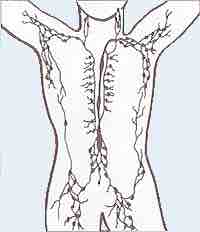The cardiovascular and lymphatic are both integral parts of the circulatory system. The cardiovascular system basically moves blood throughout the body. While the lymphatic system is part of the circulatory system, comprising a network of conduits called lymphatic vessels. Rather than blood the lymph systems carries a clear fluid called lymph (from Latin lympha, meaning "water goddess") unidirectionally towards the heart. The lymph system is not a closed system. The circulatory system processes an average of 20 liters of blood per day through capillary filtration which removes plasma while leaving the blood cells. While the circulatory system is essential for survival, it also is the source of a major problem when dealing with microbial infections. Many microbes take advantage of the circulatory system to spread throughout the body. Not surprising then the lymphatic system is critical for the bodies immune response to microbial infections. Lymphatic organs play an important part in the immune system, having a considerable overlap with the lymphoid system. Lymphoid tissue is found in many organs, particularly the lymph nodes, and in the lymphoid follicles associated with the digestive system such as the tonsils. Lymphoid tissues contain lymphocytes, but they also contain other types of cells for support. The system also includes all the structures dedicated to the circulation and production of lymphocytes (the primary cellular component of lymph), which includes the spleen, thymus, bone marrow, and the lymphoid tissue associated with the digestive system.
As well as filtering the lymph, lymph nodes produce the white cells known as lymphocytes. Lymphocytes are also produced by the thymus, spleen and bone marrow. There are two kinds of lymphocyte. The first attach invading micro organisms directly while others produce antibodies that circulate in the blood and attack them. When micro-organisms invade the body, or the body encounters antigens (such as pollen), antigens are transported to the lymph. Lymph is carried through the lymph vessels to regional lymph nodes. In the lymph nodes, the macrophages and dendritic cells phagocytose the antigens, process them, and present the antigens to lymphocytes, which can then start producing antibodies or serve as memory cells. The function of memory cells is to recognize specific antigens in the future. The function of the lymphatic system can therefore be summarized as transport and defense. It is important for returning the fluid and proteins that have escaped from the blood capillaries to the blood system and is also responsible for picking up the products of fat digestion in the small intestine. Its other essential function is as part of the immune system, defending the body against infection .

The lymphatic system
This diagram shows the network of lymph nodes and connecting lymphatic vessels in the human body.
While the lymph nodes do battle infections, there are problems with lymph nodes and the lymphatic system. During infection of the body the lymph nodes often become swollen and tender because of their increased activity. This is what causes the swollen ‘glands' in your neck during throat infections, mumps and tonsillitis. Sometimes the bacteria multiply in the lymph node and cause inflammation. Cancer cells may also be carried to the lymph nodes and then transported to other parts of the body where they may multiply to form a secondary growth or metastasis. The lymphatic system may therefore contribute to the spread of cancer. Inactivity of the muscles surrounding the lymphatic vessels or blockage of these vessels causes tissue fluid to ‘back up' in the tissues resulting in swelling or edema.